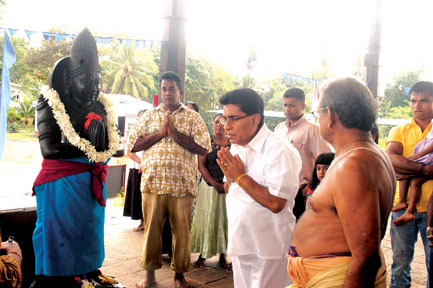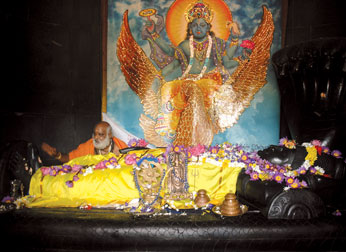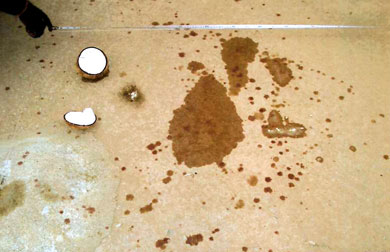|
Uthpalavarna Sri Vishnu Temple:
Divine blessings for Sri Lanka
By Thulasi MUTTHULINGAM
On the main road leading from Colombo to Kelaniya, there is a small
newly paved turnoff, just past the Kelaniya Pradeshiya Sabha. It leads
to a very unpretentious little temple, which has a very tranquil, rural
mystique about it. It houses the guardian deity of Sri Lanka, Vishnu,
and has a history much more amazing than its current appearance.would
suggest. Plans are afoot however to further expand it. It is a replica
of the deity of the largest temple in the world, Sri Rangam in India.
 |
|
Minister of Public Relations and
Public Affairs Mervyn Silva worshipping the deity of
Vibishana |
To appreciate this story one needs to trace its origin - way back to
the Ramayana. At that time too Sri Lanka had been engulfed in a
horrendous war and when it ended, Vibishana, the brother of Ravana was
crowned king. Believing his brother to be in the wrong, he had chosen to
support Sri Rama, the prince from Ayodhya in the war.
Precious gift
When Ram went back to Ayodhya from Sri Lanka for his coronation,
Vibishana accompanied him. When the ceremony was over, he was presented
a very precious gift by Ram as a token of his esteem and affection; the
statue of the guardian deity of Ram's lineage, which had been handed
down and worshipped in his family for generations.
"Henceforth, he will act as the Guardian Deity of Sri Lanka. Take the
statue with you back to Sri Lanka but make sure you don't drop it on
your way as it will cleave to the ground and you will not be able to
lift it again" were Ram's instructions to Vibishana.
Vibishana faithfully carried the statue over the hills and streams
but whilst passing the Kaveri river in South India, he decided to have a
dip. Looking around, he spotted a young boy standing nearby and asked
him to hold the statue. The boy said that he would hold the statue until
it got too heavy for him in which case he would call Vibishana thrice.
The king agreed and dived into the water where he didn't hear the
immediate three calls of the boy. The boy was in fact the elephant
headed God Ganesh, who wanted to trick Vibishana into leaving the Sri
Ranganathar statue back in India. When Vibishana surfaced he saw to his
outrage that the statue had been placed down and the boy was running
away. He chased the boy all the way up a hillock and into a temple where
he dealt a blow on his head. Thereupon, the boy changed to his true form
of Ganesh and Vibishana, though realising he had been tricked promptly
apologized. This is the famous Utchi Pillayar (Ganesh on a hillock top)
temple in Sri Rangam, Tamil Nadu, where the presiding deity sports a
dent on his forehead - evidence of Vibishana's blow.
Though he had been told that the statue once dropped could not be
lifted again, Vibishana nevertheless tries to do so with all his
strength - to no avail. As he sits back in despair with his head in his
hands, a voice from the Heavens spoke: "Vibishana, leave me here. I am
now facing South where my gaze is directed towards Sri Lanka. I will act
as your Guardian Deity all the way from here."
Fresh hope
A disheartened Vibishana, given fresh hope, left the deity and went
his way. There, in Sri Rangam in Trichy, South India, the deity remained
with his gaze directed towards Sri Lanka. In course of time, Maharajahs
of various dynasties, the Cholas, Pallavas, Pandhyas and Nayaks, all
contributed towards building and expanding a temple for him. Sri Rangam
is now a mini city and according to established sources the largest
functioning temple in the world.
Kings over the ages kept expanding the temple and built 20 gopurams
(towers) - all in the North, East and Western directions.
The South where the deity's head lay was kept free of towers as the
temple folklore maintained that Vishnu's gaze on Sri Lanka should not be
obstructed.
Nevertheless, there are recorded instances of some Kings attempting
to build a Gopuram in the South. Reportedly, either the structures kept
crumbling or the King had a dream in which the presiding deity appeared
and asked that his gaze on Sri Lanka not be blocked. In 1977 a South
Indian religious luminary, the 44th Jeeyar Swami of the Ahobila Matt
undertook the task abandoned by kings, of building a southern tower for
Sri Ranganathar.
He was supported by the then Chief Minister of Tamil Nadu, M.G.
Ramachandran and within 10 years, the tallest temple structure in the
world - sthe 236 feet high Raja gopuram (king of towers) - was built.
 The swami at this time was 99 years and had a huge amount of support
but there was a big hue and cry against the building of the gopuram as
well. The swami at this time was 99 years and had a huge amount of support
but there was a big hue and cry against the building of the gopuram as
well.
Key reason
The rock edicts and history of the temple were evoked, citing danger
to Sri Lanka if its guardian deity's gaze on it should be blocked. Many
Hindus in Tamil Nadu and Sri Lanka believe that the building of the
gopuram was one of the key reasons for the eruption of the prolonged
conflict in Sri Lanka. So did many Buddhists.
Apparently President Premadasa was told by his astrologers that the
only way to negate the problem was to build a similar temple in Sri
Lanka and instal Vishnu as the Guardian Deity in Sri Lanka itself. He
had tried but could make no headway before his sudden demise.
The next in power to try very hard to accomplish this feat was
President Chandrika Bandaranaike Kumaratunga. She donated 20 acres of
land in Muthurajawela as well and had the statue commissioned to be made
in India. However, for various reasons the project could not be
completed while she was in power and the statue though completed,
remains in storage in India to this day. The Uthpalavarna Sri Vishnu
Temple, was consecrated on January 21, 2010 and the conflict ended in
May 2009. The deity who brought to Sri Lanka in 2008. Minister Mervyn
Silva the patron of the temple in whose constituency it is built, said
he hoped to expand the temple and welcomes public donations. I am
available at any time to anyone who wishes to make any kind of
contribution to this temple," he said.
The Minister who says he fasts on Wednesdays to invoke Vishnu's
blessings (Wednesdays and Saturdays being sacred days for Vishnu), said
that at the time of the Kumbhabishekham of the temple on January 21, six
eagles flew overhead. The eagle is the vehicle of Vishnu, which he is
regularly said to use as his messenger or errand runner. According to
the priests of the temple, an eagle appears regularly around noon every
day. This was borne out on the day we visited when an eagle appeared at
exactly twelve noon and circled the temple, for a full 10 minutes. The
eagle as the Vehicle of Vishnu enjoys pride of place in the temple by
being placed directly opposite him. In the temple here, that position
has been given to Vibishana.
"The place is given to the vehicle of Vishnu," explains Guruji Gopal
Sharma, one of the priests instrumental in overseeing the building of
the temple. "In this case, the person who tried so hard to accomplish
this feat of carrying Vishnu to Sri Lanka was Vibishana and so, we have
given the place to him." Guruji Gopal Sharma and Guruji Somaskanda
Sharma of Munneshwaram, who is the chief priest of the Uthpalavarna Sri
Vishnu temple had been appointed by Minister Mervyn Silva to oversee the
construction of the deity and temple. According to them, they went to
Kerala to consult highly experienced astrologers for advice on how such
a temple could be constructed, to bring peace to Sri Lanka.
The astrologers gave several guidelines on how the temple should be
built. Among them were:
- the temple should be situated within 25 kms of the capital.
- It should be constructed on virgin land (never used by humans for
habitation, cultivation or any other purpose)
- The land should be surrounded by a water body
- The land should somehow be connected with Vibishana.
According to Somaskanda Swamy, they found it difficult to find a
place which fulfilled all the requirements. Of primary difficulty was
finding virgin unused land within 25 km of the capital. "We looked in
various places without being able to satisfy all the conditions. Then
one day, when we were near this area, we saw an eagle swooping low on
the ground across a field. In what seemed to be unusual behaviour, it
kept on circling the ground until we thought it might be an omen and
came to investigate.
Granite Statue
 |
|
The dashed coconut water on the
ground, where Vishnu’s statue is currently placed. |
"We found that the surrounding areas were used for paddy cultivation
but the area which the eagle circled was pitted and unsuitable for such
a purpose. So it had been left alone as virgin land and it was indeed
surrounded by a water body - the canal that watered the neighbouring
fields. And this is Kelaniya, said to be the city from which King
Vibishana ruled. We had thus found a land that fulfilled all the
requirements. I believe that it has waited all this time, just for Him."
A granite statue, a replica of the Sri Ranganathar statue in Sri
Rangam was commissioned from Mahabalipuram in India. The statue arrived
in good time and when the temple was ready to have it installed, a
coconut was dashed on the ground as it was auspicious. "The coconut
water formed the shape of Sri Lanka with India above it" says Somaskanda
Swamy. "We took this to be an auspicious omen, proof of Vishnu's
blessings and even sent the photograph taken to the President."
The temple will celebrate its first major festival Vaikuntaekadasi in
December when Vishnu's gates to Heaven are said to be open to all
devotees. The festival will start on December 1 and conclude on December
17. On December 18, the guardian deity brought expressly to bring peace
to the country will enjoy his first chariot ride on an elephant.
|

